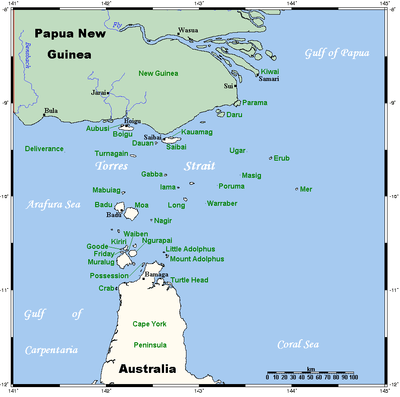Darnley Island (Queensland)
Darnley Island or Erub in the native language, is an island formed by volcanic action and situated in the eastern section of the Torres Strait, Queensland, Australia.[1] It is one of the Torres Strait Islands and is located near the Great Barrier Reef and just south of the Bligh entrance. The town on the island is also called Darnley but the locality is called Erub Island, both being within the local government area of Torres Strait Island Region.[2][3]
| Native name: Erub | |
|---|---|
.png) A satellite image of Darnley Island | |
 A map of the Torres Strait Islands showing Erub in the north-eastern waters of Torres Strait | |
| Geography | |
| Location | Torres Strait |
| Coordinates | 9.587°S 143.771°E |
| Archipelago | Torres Strait Islands |
| Total islands | 1 |
| Administration | |
Australia | |
| State | Queensland |
| Demographics | |
| Population | 400 |
| Darnley Island / Erub Island Queensland | |
|---|---|
 Darnley Island / Erub Island | |
| Coordinates | 9°35′48″S 143°45′48″E |
| LGA(s) | Torres Strait Island Region |

Approximately 400 people live on Darnley Island. There are two stores, one school and a health centre. Accommodation is available through Norah's Guest House and the council run 'five star' dongas.
The effective community language is Brokan (Torres Strait Creole), though many people still speak Meriam Mir, the traditional language.
Darnley Island became better known around Australia in 2015 when the acting school principal asked via social media for donations of books to assist her primary school children and their education. Her efforts resulted in more than 18000 shares on Facebook and hundreds of books being sent to the island.[4]
History
The island was named by Captain William Bligh in 1792 during his second breadfruit voyage to the Pacific, after his distant relative, the Earl of Darnley.[1][2]
Christianity was first introduced to Darnley and the Torres Strait region by the London Missionary Society, when Rev. Samuel Macfarlane arrived at Kernus,[5] on Erub on 1 July 1871. The Islanders refer to this as "The Coming of the Light", or "Coming of Light",[6] and all Island communities celebrate the occasion annually on 1 July.[7]
Before this, pearlers and beche-de-mer gatherers visited the island. Over many years, these industries attracted an influx of seamen from the Pacific Islands, the Philippines and Malaya, many of whom married local women and settled on the island.
Early in the twentieth century, the Queensland Government started installing various facilities such as a school, medical aid, post office and an Island Industries Board store.
Darnley people have been at the forefront of the movement for adequate recognition of Torres Strait Islanders' rights, with George Mye among the most prominent advocates of Islander interests from the 1960s to the 90s and Carlemo Wacando among the first to challenge the legal notion of terra nullius.
Pau Enterprises Indigenous Corporation was established in 2015 to manage and maintain the Pau family native title lands and interests on Darnley Island. It also seeks to create social enterprises on Darnley Island and other locations where community members have migrated to, such as Cairns.[8]
Flora and fauna
The Kinabalu giant earthworm, Pheretima darnleiensis, is named after Darnley Island, although it is likely not a native but an introduced species there.[9]
Heritage listings
Darnley Island has a number of heritage-listed sites, including the All Saints Anglican Church.[10]
Amenities
The Torres Strait Island Regional Council operate an Indigenous Knowledge Centre at Madige Village on Erub.[11]
References
- "Darnley Island - island (entry 9371)". Queensland Place Names. Queensland Government. Retrieved 8 April 2014.
- "Darnley Island - town (entry 9372)". Queensland Place Names. Queensland Government. Retrieved 8 April 2014.
- "Erub Island - locality (entry 46716)". Queensland Place Names. Queensland Government. Retrieved 9 March 2017.
- "Thank you from Erub Erwer Uteb". Tagai State College. Queensland Government. Archived from the original on 2 February 2017. Retrieved 26 January 2017.
- "Dr Ken Thaiday Senior". Australia Council. 15 May 2019. Retrieved 14 April 2020.
- "Aboriginal Christians & Christianity". Creative Spirits. Retrieved 15 April 2020.
- Burton, John. "History of Torres Strait to 1879 – a regional view". Torres Strait Regional Authority. Archived from the original on 15 May 2009. Retrieved 3 July 2011.
- "The Proposal Summary: Outline of Project Goals" (PDF). Archived (PDF) from the original on 26 April 2018. Retrieved 26 April 2018.
- Blakemore, R.J.; C. Csuzdi; M.T. Ito; N. Kaneko; T. Kawaguchi; M. Schilthuizen (2007). "Taxonomic status and ecology of Oriental Pheretima darnleiensis (Fletcher, 1886) and other earthworms (Oligochaeta: Megascolecidae) from Mt Kinabalu, Borneo" (PDF). Zootaxa. 1613: 23–44. Archived (PDF) from the original on 10 April 2008.
- "All Saints Anglican Church (entry 600873)". Queensland Heritage Register. Queensland Heritage Council. Retrieved 16 July 2013.
- "Erub Island Indigenous Knowledge Centre". Public Libraries Connect. State Library of Queensland. 28 August 2017. Archived from the original on 5 February 2018. Retrieved 5 February 2018.
External links

- Mye on behalf of the Erubam Le v State of Queensland (2004) FCA 1573 (8 December 2004)
- Passion and Professionalism by Dorothy Walker and Lynetee Griffiths about an education project for indigenous students on Darnley Island, a 2 min 42 sec video, published by State Library of Queensland as part of Storylines:Q150 digital stories